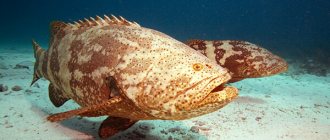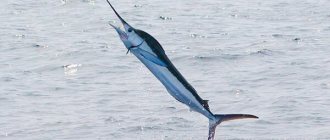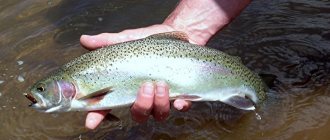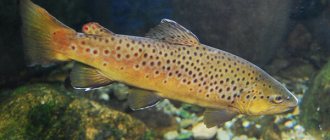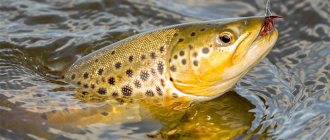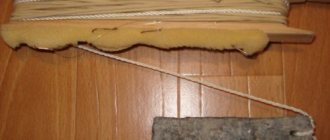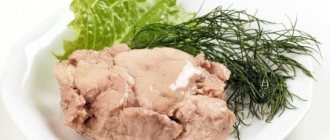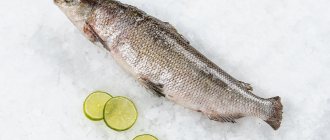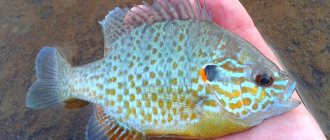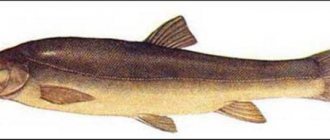The snakehead is one of the most unusual freshwater fish; it got its name because of its incredible resemblance to reptiles. The snake-headed fish is native to South and Central Asia. The snakehead is incredibly strong and very beautiful, although many are frightened by its appearance and completely in vain, it does not pose any threat to humans. Like reptiles, snakehead fish have more than thirty different subspecies, which differ in both the size of the individuals and their color. Those fishermen who have caught him at least once note his fighting qualities and incredible resourcefulness, which is why he is of genuine interest to fishing enthusiasts. And the gastronomic properties will not leave even the most sophisticated gourmet indifferent.
Names of river and lake fish species
Freshwater fish cannot live in seawater. However, the same representative of waterfowl can live in lakes and mountain rivers with rapid currents. But some species do not always remain in one place throughout their lives: they swim to the seas to spawn.
The list with the names of species of river and lake inhabitants included only those that have the greatest industrial, culinary value or are interesting from the point of view of behavioral factors. Look carefully at the photo of each representative in order to learn to distinguish one species from another, because the taste qualities of each type of fish are unique.
Predatory fish: types, habits, features and photos
Pike
Pike is a prominent representative of predators. Adult fish grow up to 16 kg in weight, but there are also giants weighing up to 25 kg. A distinctive feature of pike is the presence of small sharp teeth and high-set eyes. The color of the pike is gray, which allows it to remain unnoticed in the depths of the waters. Moreover, the body color of those fish that live at depth is much darker than those that swim on the surface.
The fish prefers to live along the coastline and hide in dense bushes or creeks. Anglers need to be careful when trying to remove a pike from a hook, because its teeth can seriously injure your finger.
Pike - orderly of rivers and lakes
Zander
This is another representative of predatory fish species. He prefers to live alone, and only in his youth does he gather in small flocks for the sake of a successful hunt. The predator is active around the clock, at any time of the year. During the day, he prefers to hide in holes and rise to the surface at night.
Pike perch lives only in clean waters and hunts in a very original way. It first stuns its prey with its tail and then eats it.
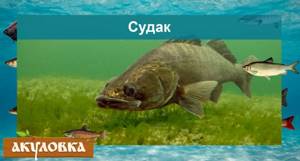
Pike perch only feeds on fry because its throat is very narrow.
Bersh
This is a fish that looks similar to pike perch. It also belongs to the species of predatory fish, but it is not active around the clock, but only in the early morning or late evening. Bersh prefers to hunt and live at great depths.
A distinctive external characteristic of the fish is the presence of scales on its fins. In terms of its hunting method, the bersh is also similar to the pike perch: before swallowing the prey, it stuns it with its tail.

Bersh is a fish that lives only in large reservoirs
Perch
The brightest and most active predator. Perches are rarely large in size. They live in schools, and the fewer individuals, the larger the flock. The fish is unpretentious in food: the predator does not disdain any protein food (worms, larvae or small fish). Perch destroys small things, which very often annoy fishermen. Therefore, it is released into some ponds specifically in order to rid the reservoir of little value from a fishing point of view.
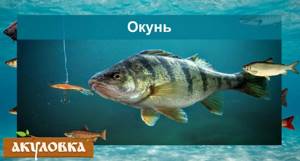
Perch lives everywhere. The only place where you can't find him is Spain
Ruff
This predator is the most voracious. It hunts around the clock and at any time of the year. The predator lives everywhere, even in those reservoirs where the water is very dirty. The ruff reacts poorly to increased water temperatures and the lack of sufficient oxygen in it. In such conditions, he quickly dies.
Despite the fact that the ruffe is aggressive, other predators are not averse to feasting on them: pike, catfish, etc.

Ruff sees practically nothing under water due to poor eyesight. When searching for prey, it is guided by water fluctuations.
Burbot
This is the only representative of cod fish species that is able to live in fresh water. Burbot hibernates in the summer, when the water temperature rises to 14-16 degrees. He does not like warm water and cannot hunt in such conditions.
In terms of external characteristics, burbot is very similar to catfish, but may have colored spots on its body. The color of the fish may change depending on the color of the bottom.

The favorite prey of burbot is the ruff. Therefore, fishermen often use spiny fish as bait.
Som
These are predatory fish that are nocturnal. They feed on both small and large fish. Their wide mouth allows them to swallow large fish.
Catfish are bottom-dwelling fish. Fishermen note that it takes a lot of effort to catch a large predator. However, from the point of view of culinary characteristics, the fish is of little value. Catfish meat is fatty and has a distinct muddy smell.

The weight of the largest catfish reached 400 kg. There is still debate about whether a catfish is capable of eating a person or not.
Piranhas
These small fish live in the rivers of South America and countries with warm climates. In Russia, they can also successfully survive in reservoirs where unscrupulous aquarists throw them out.
The appearance of predatory fish is terrifying - they have a massive lower jaw with wedge-shaped teeth pushed forward. This tooth structure adds destructive power to a fish bite.
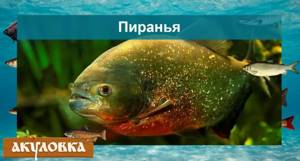
A small piranha can crush a wooden stick with a diameter of 2 cm
Gustera
Fish are conditional predators. The young will not attack smaller prey and prefer to feed on plankton. But as fish grow older, they add animal foods to their diet, including shellfish and small fish. The silver bream is an inactive and non-aggressive predator.

This is the only representative of waterfowl in rivers and lakes that has no relatives. Ichthyologists classify the silver bream as a cyprinid, but there is still debate on this issue
Chop
This is a small fish, the weight of which rarely exceeds 300 g. For fishermen, catching a chop is a great success. The predator hunts only at certain hours - usually after sunset and is very sensitive to changes in temperature and atmospheric pressure.
Chop, despite its small size, is not afraid of other, more aggressive and larger predators. His shawls have sharp thorns, which, in moments of danger, dig into the enemy's throat.
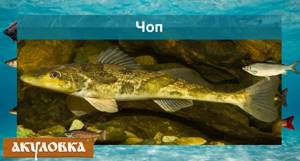
Chop is listed in the Red Book in many countries, as it is an endangered species of river and lake inhabitants.
river eel
This is one of the most unusual types of predators. He hunts different types of fish, including pike. It prefers to live in rivers with a sandy or muddy bottom. The eel lives only in those bodies of water that have access to the sea. Outwardly, it looks more like a snake than a fish.
Upon reaching 8-10 years of age, adult individuals migrate from fresh water bodies to the seas. There they lay eggs and die.
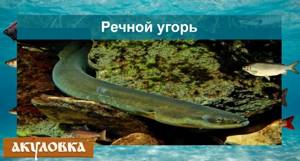
Eel larvae are transparent in color. Thanks to this, they remain undetected by dangerous predators
Snakehead
This is another predator with an elongated body shape. The snakehead is a unique predator: it can eat almost any fish that is smaller in size, as well as small rodents. In addition, it can move across land from one body of water to another thanks to its muscular body.

Cases have been recorded of snakeheads going without water for 1 week. All this time he was on land and breathed only air
Chub
Pisces prefers to live on a rocky bottom and does not like silt and dirt. It feeds on larvae, worms and insects that fall into the water.
Chubs are very careful, so when they see a person they immediately hide in secluded places. You can lure them out of their shelter using various baits, because the chub is an extremely curious fish.

The chub is an active and very strong predator. Cases of chub attacking waterfowl have been recorded.
Ide
This species of fish is one of the few that can live in both salt and fresh water. In freshwater bodies of water, ide likes to hide in holes, snags and silt.
The ide is a predator because it can prey on frogs and their tadpoles. However, young individuals prefer to feast on plant foods and insects.

Ide is a long-liver - its life expectancy in favorable conditions is 20-25 years
Asp
Fishermen call this type of freshwater fish a snatch. This is due to the behavioral factor of the asp. It begins hunting as a juvenile and attacks small fish and roaches. However, these attacks are often unsuccessful because the asp has a very small throat.
This type of fish lives only in flowing waters. And avoids settling in stagnant bodies of water.

An asp attacks a school of small fish. He breaks in and grabs the victim
Whitefish
Whitefish belongs to the salmon species of fish. He loves cold and clean water. Highly valued due to its unique taste characteristics.
Different types of whitefish can differ greatly in appearance, but the fish also have common characteristics: they have a shortened upper jaw, and teeth on the lower jaw often fall out.

Whitefish is an aggressive predator. It hides from larger fish and destroys small lake fish in reservoirs
Peaceful species of fish: description with photos and brief characteristics
Peaceful species differ from predators by the absence of teeth. They have only small pharyngeal teeth, which allow them to better process and assimilate plant foods. However, the structure of the oral cavity of peaceful fish is not initially intended for processing rough food.
Fishermen prefer to hunt peaceful species. There are several reasons for this. Firstly, they are represented by greater diversity than predators. In addition, peaceful ones are caught almost all year round and do not react to changing weather conditions.
Sopa
This fish is very similar in appearance to bream. But it is valued more in terms of taste characteristics: its meat is tender and juicy. The value of this fish is added by its small population. Sopa lives in small colonies and even under artificial conditions it cannot be bred on an industrial scale.
When the fish are removed and the water is removed. its color changes. The body becomes soft, the scales fade.

Fishermen distinguish the sopa from its counterpart, the carp, by its silvery iris and more pronounced black pupils.
Taran
It is also called a ram. It is very much appreciated by lovers of dried fish. The peaceful inhabitant of rivers and lakes is picky about food, and even when hungry will not consume garbage. Because of this, taranka meat has a sweetish taste.
Fish live in large schools. It is not difficult for a fisherman to catch them, since they are present in abundance in water bodies and are caught on an industrial scale.

In order to prevent the population of the taranka from declining, Russia has established restrictions on its catch: only adult individuals with a body size of at least 14 cm can be taken from water bodies
Roach
This is the main source of food for large predators. Only a small proportion of individuals survive to adulthood, despite the fact that the fish is very shy and cautious. In the Northern regions, roaches are caught and exterminated en masse, since the fish are very voracious and reduce the amount of food for more valuable fish species - salmon and trout.

The largest roach caught had a maximum weight of 3 kg
Bream
This fish is a favorite among fishermen. Its meat is delicious in any form - fried, dried, smoked. The success of fishing depends on how correctly the place where the bream may be found is chosen.
Bream hunt collectively and remain alone only before spawning. Before breeding, males actively court females, jump out of the water and make ruts from plowed silt at the bottom of reservoirs.

Bream is a fish that is often infected with helminths. Therefore, heat treatment of fish before eating is an important condition for its safe consumption.
crucian carp
There are 2 names for crucian carp - silver and golden. The latter adapt better to environmental conditions and can be active even with a reduced oxygen concentration in the water.
Crucian carp is active only in the warm season. Spawning of peaceful fish occurs after the water temperature warms up to 16 degrees.

River and lake crucian carp rarely gain weight more than 3 kg. This is due to the fact that they prefer predominantly plant foods
Tench
This is the laziest and most immobile species of peaceful fish. He loves only stagnant bodies of water and remains motionless for a long time. Tenches hide in algae and coastal vegetation, and in case of danger they are completely buried in the silt.
During their life, fish grow very slowly. The size of the largest individuals rarely exceeds 16 cm

Fishermen notice that tench are very reluctant to bite, and in winter they are practically inactive
Chekhon
This peaceful fish is a schooling species. It is otherwise called saber fish due to its unusual body structure. The saberfish settles in clean reservoirs, where there are no algae and silt.
Fishermen love sabrefish for its taste. Fried, smoked and dried - this fish will be sweet and fatty no matter how you cook it.

Chekhon is a small species of freshwater fish. It rarely exceeds 60 cm in length and weighs no more than 1 kg
Rudd
Externally, the fish resembles a roach, but has a bright fin color - red or bright crimson. Rudd loves warmth, so in the hot season it will rise to the surface to bask in the sun. The peak of the bite occurs in the summer or during the winter thaw.

Rudd is also called “goldfish” because of the ability of its fins and scales to shimmer in the sun.
Podust
This peaceful fish was common in the 19th century. Now the population of podust has decreased due to poor ecology. Freshwater inhabitants prefer plant foods, larvae and worms, but can also feast on asp caviar.

Podust can only live in clean water bodies. Any water pollution has a detrimental effect on fish
Bleak
Fish is ubiquitous. This is the most active species of peaceful fish. Following its prey - insects, the bleak is capable of jumping out of the water. Fishermen also assessed the activity of bleak when catching it with live bait.
The maximum lifespan of fish is 7-8 years. In 90% of cases, the main cause of bleak death is an attack by predators.
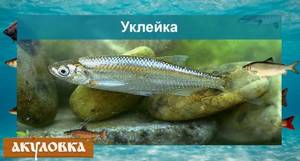
The weight of bleak rarely exceeds 50 g
Bystryanka
The behavior of the fish also resembles that of the bleak. They differ slightly in appearance from bleaks in that they have a wider head shape and live less - up to 6 years.
Bystryanki lead a gregarious lifestyle. They spawn at temperatures above 15 degrees.

The female bystryanka lays a large number of eggs. Their weight often exceeds the weight of the fish itself
Gudgeon
The fish can live in reservoirs with sandy and rocky bottoms. The diet of minnows consists of worms, mollusks and small crustaceans. The fish is active only during the day. Fishermen say it is almost impossible to catch it at night.
The gudgeon spawns in mid-spring. Spawning is accompanied by noise and increased activity of peaceful river inhabitants. Females lay eggs on driftwood, stones and coastal vegetation.

In winter it is almost impossible to catch minnows. He goes to great depths
White amur
Fish live in rivers and eat exclusively plant foods. For this reason, fishermen go to catch grass carp using semolina or millet. White Cupid bites best during the daytime. But it is extremely difficult to fish it out, because it has great strength and speed.

There are several types of fish. The rarest of them is black carp with a darker body color and black fins.
Silver carp
Silver carp belongs to the group of river commercial fish. The value of fish is due to its tasty meat, which contains very few bones. But fishermen need to behave very carefully and carefully so as not to scare away the peaceful silver carp.
Silver carp spawn at the beginning of summer, when the water temperature warms up to 20-22 degrees.

The largest silver carp reach 1 meter in length and 20 kg in weight
Loach
Another interesting representative of peaceful fish. The body of the loach has an elongated shape, like a snake. The fish prefers to live in silted reservoirs and hide at the bottom of rivers and lakes from predators. The body color of the loach completely blends with the bottom, so it rarely becomes a victim of predators.
The fish's preferred food is shellfish and worms. Loaches are very willing to bite on this bait. However, when fished out of the water, they emit a high-pitched squeak.

Female loaches can lay more than 1,500,000 eggs at one time
Char
The fish is variegated in color. The gray body has many bright yellowish spots. Char is one of the smallest peaceful fish. It rarely reaches more than 12 cm in length.
Char prefers to feed on plankton, worms and other insects.

Char is very picky about water quality. It cannot live in polluted rivers and lakes
Lamprey
A fish with an elongated body lives in large rivers - Don, Dnieper. In recent decades, its population has decreased due to environmental degradation.
The lamprey cannot be called a predator and a peaceful inhabitant of fresh water bodies. She's more of a parasite. The fish attaches itself to the victim using special suction cups and feeds on the latter’s blood.

The lifespan of lampreys is up to 2 years
Sterlet
This fish is the most developed species of all peaceful ones. They live in groups and create strong pairs. In cold weather they eat practically nothing, but in summer they eat vegetation and eggs of other fish.
In ancient times, sterlet was served on royal tables. But fish are not harvested on an industrial scale, as laws limit this process.

Sterlets can live up to 30 years in suitable conditions
Salmon
Brook or river salmon are on the verge of extinction. This is due to the fact that the regions where they live are experiencing a serious environmental crisis.
Salmon spawn upon reaching sexual maturity - 6-8 years and live on average 20 years.

Salmon feed mainly on insects, but in rare cases they can attack small fish
Trout
Trout live in turbulent freshwater mountain rivers or lakes. It reproduces only in the cold season, when the water temperature does not exceed 7-8 degrees.
The river dweller prefers insects and plankton as food. There have been cases when trout attacked frogs. The maximum dimensions of adults are 50 cm in length and 3 kg in weight.

This fish is very popular due to its unique taste characteristics.
Sturgeon
Sturgeon is a large, peaceful fish. Its body length can reach 6 meters.
The female can lay eggs equal to ¼ of her own weight at one time. But despite high fertility, the sturgeon population is constantly declining. Because of this, they were listed in the Red Book.

The sturgeon is considered a long-lived freshwater fish. Some individuals live up to 100 years
Grayling
It has a characteristic color: there are bright pink spots on the gray body. Grayling can attack small fish, but it cannot be called a full-fledged predator, because the vast majority of its diet consists of plant foods.
Grayling weight gain directly depends on environmental conditions. In bad conditions he gains a maximum of 1 kg, in good conditions he can gain 3 or more kg.

There are 3 types of grayling in the world: European, Siberian, Mongolian. The first one is considered the most numerous
Umber
The fish belongs to both river (lake) and decorative species. The maximum length of the body of males is 12 cm, and that of females is 15 cm.
Most often, umbers live at the bottom of a river or lake, because it is easier for them to hide from predators there. The special structure of the oxygen bubble allows peaceful fish to stay under the silt for a long time.

Umbras do not live long - males up to 3, and females up to 5 years
Carp
This fish is distributed in limited areas - in river basins that flow into the Black Sea and in the lower part of the Don. Carp is popular among fishermen due to its tender and unique-tasting meat.

The carp is a river fish that is listed in the Red Book of Russia
Habitats
Bystryanka prefers not too warm water. Lives in wide, fast rivers, in the middle of the current.
Moves in flocks. Stays close to the surface of the water to make feeding easier.
The distribution area is wide. Lives everywhere in Europe. The rivers of France, Belgium, and German lands are inhabited by nimble fish. The species is found in Poland and Ukraine.
It is found along the northern coast of Asia Minor (to the mouth of the Tigris and Euphrates). Recorded in water bodies of Central Asia.
In the vastness of our country, it lives in the Moscow, Tver, Samara, and Voronezh regions. In the west it is found in the Kaliningrad region, the Baltic basin zone. The Don, Kuban and Volga are full of representatives of this species.
The rivers of the Black Sea coast and Transcaucasia are also rich in this fish.
Short cycle fish. It may completely disappear from the reservoir for several years. Then its numbers are restored on their own.
Some researchers distinguish separate subspecies of Russian, southern and European bystryanka. Others insist that it is a single species.
Benefits and harms of river fish: meat, caviar, milt
River fish contains about 20% protein. Fat ranges from 0.1 to 54%. When determining the nutritional value of fish, not only the amount of fat is taken into account, but also where it is located. There are fish that accumulate fat in the abdomen, liver, subcutaneous layer or at the base of the fins. But the most valuable fish is considered to be the one in which the fat is evenly distributed in the muscles.

Fish is a valuable source of protein
Fish from a river or lake is a low-calorie product. On average, its nutritional value ranges from 80 to 90 kcal. Only some types of freshwater fish have a calorie content of more than 100 kcal.
Useful properties of fish
A unique combination of chemical elements contained in river and lake fish helps normalize cardiovascular activity and significantly reduces the risk of cancer.
- The protein contained in fish is involved in the formation of muscle tissue, which is why it is often included in the menu for athletes. In addition, due to its low calorie content, freshwater fish dishes are recommended for overweight people.
- Vitamin D promotes the absorption of calcium, strengthens teeth, bones and hair. In addition, it shortens the rehabilitation period after fractures and prevents the occurrence of osteoporosis.
- Vitamin A and polyunsaturated fatty acids Omega-3 acids improve vision, promote cell regeneration and slow down the aging process. With regular consumption of fish dishes, skin tone increases and small facial wrinkles are smoothed out.
- Methionine reduces bad cholesterol in the blood, thereby helping to prevent the formation of cholesterol plaques. Doctors believe that methionine prevents the formation and development of Parkinson's disease.
- Zinc has a beneficial effect on male potency and improves sperm quality.
- Magnesium is indicated for nervous tension, protects against stress and helps normalize sleep. Regular intake of magnesium reduces nervousness and irritability.

Fish from the carp family is added to the diet for thyroid diseases.
Harm to river and lake fish
Despite all the benefits, river fish can also pose a potential threat to health. Fish should be consumed carefully, or completely excluded from the diet, by people with a severe allergic reaction. The substances it contains can cause skin rashes.
There are other factors that indicate that fish may be harmful.
- Infection with helminths or other parasites. Eating such fish risks infection. Therefore, fish must be carefully inspected before purchasing, and be sure to be thermally treated.
- Accumulation of toxins and heavy metal salts in meat. When purchasing, you should find out its origin as completely as possible.
- Quick spoilage (especially in the hot season). It must be prepared no later than the next day after purchase.
Dried and salted fish are harmful to hypertensive patients and people with diseases of the urinary system. Many species of river and lake fish contain many small bones. They can scratch not only the larynx, but also the intestines.
River fish caviar: benefits and harms
River fish caviar is in no way inferior to fish meat in its beneficial properties. In addition to protein, which is contained even more than fish meat, it contains large quantities of vitamins A, B, D, E and a complex of microelements, polyunsaturated acids.

Calorie content depends on the type of fish. The most nutritious is beluga caviar, and the most dietary is pollock, cod and pike.
The most popular caviar is pike and crucian carp, but they are in no way inferior to the caviar of pike perch, mullet and roach.
Caviar is divided into red, obtained from salmon fish, black sturgeon, pink from cod or pollock, yellow - sometimes called white - from pike perch, pike and other freshwater fish. Each is tasty and healthy in its own way.
The calorie content of yellow caviar is about 132 Kcal. It contains 27.9 g of protein, 1.8 g of fat, and 1.1 g of carbohydrates.
Useful properties of caviar:
- maintains the overall tone of the body,
- normalizes heart pressure,
- participates in the production of collagen.
- removes toxins and waste products from the body.
- prevents the onset of Alzheimer's disease.
One of the popular aphrodisiacs is considered to be dishes using caviar. It not only increases potency, but also improves sex life.
Harm to caviar can be caused by a high salt content, which is harmful for people with diseases of the genitourinary system, or possible allergies.
Interesting: the peoples of the Far North make an energy drink from whitefish caviar. To do this, fresh caviar is mixed with water and salt. The mixture is thoroughly ground. After some time, whitefish caviar completely dissolves, and you get a drink that restores strength.
River fish milk: benefits and harms
Milt is sperm that is located in the abdomen of males in a special film. They are milky white in color, hence their name.
The calorie content of milk is low - about 90 grams per 100 grams of product. Protein content - 16 g, fat - about 3 g. Milk also contains amino acids, vitamins and microelements.

In medicine, protamine is synthesized from milk, which prolongs the effect of drugs. This is very important for patients, for example, with diabetes
Regular consumption of milk affects the functioning of the brain and heart, normalizes cholesterol levels in the blood. Red fish milk is considered the most useful: it contains substances that have antiviral and antimicrobial effects. The sodium salt, which is isolated from milk in laboratories, is used to make immunomodulators.
In medicine, protamine is synthesized from milk, which prolongs the effect of drugs. This is very important for patients, for example, with diabetes
Milk can not only benefit a person, but also cause harm. They are contraindicated for metabolic disorders. It is also not recommended to give milk to children under three years of age due to its high allergenicity.
Interesting: in Finland, milk is valued on a par with caviar. Adding them to the ear is a must.
Tips from fishermen
Snakehead fishing is not particularly sophisticated. But still, it is worth using the following tips:
- Clearly determine the habitat of predatory fish.
- Use several types of bait for fishing.
- Periodically change the nature and speed of dragging the bait to attract a predator.
Using simple tips, you will get a truly colorful and exciting procedure for catching this representative of the deep sea. Catching this predator is notable for its spectacle and real battle of characters.
Fish recipes with photos: in the oven with and without foil
Burbot baked with vegetables and cheese
Ingredients for 4 servings:
- 800 g fillet;
- 2 onions;
- 2 tomatoes;
- 1 carrot;
- 100 g cheese;
- 2 teaspoons dried oregano;
- 2 teaspoons ground coriander;
- dill or parsley;
- mayonnaise;
- salt to taste;
- vegetable oil.

Preparation:
- Divide the fish fillet into portions, brush with mayonnaise,
- Season with coriander and salt to taste.
- Place each piece on the prepared sheet of foil.
- Cut the onion into half rings and fry in vegetable oil until golden brown.
- Add grated carrots and oregano to the fried onions. Salt the vegetable mixture.
- Simmer over low heat for about five to seven minutes.
- Place the fried vegetables on the fillet. Place diced tomatoes on top.
- Wrap the foil tightly and place it in an oven preheated to 190 degrees. Bake for 20 minutes.
- Carefully unfold the foil and, after sprinkling the cod with vegetables with cheese and chopped herbs, return to the oven for 10 minutes so that the cheese melts and browns.
Crucian carp baked in sour cream
Ingredients:
- 4 medium crucian carp;
- 250 g fat sour cream;
- 2 medium onions;
- 4 cloves of garlic;
- 1/2 lemon;
- 8 bay leaves;
- salt and ground black pepper to taste;
- a bunch of dill, parsley or cilantro.

. Preparation:
- Clean the fish: remove scales, entrails, head and fins. Blot excess moisture from the carcass with a paper towel.
- Rub with salt and pepper and sprinkle with lemon juice to remove the smell of mud. Leave for 30 minutes.
- Mix sour cream with chopped herbs and garlic. Season with salt and pepper.
- Grease four prepared sheets of foil with vegetable oil.
- Cut the onion into rings and place half of it in the first layer on foil.
- Place the prepared fish in the next layer and cover it with the remaining onion.
- Place two bay leaves on each fish.
- Wrap each fish tightly in foil and place in an oven preheated to 200 degrees for 20-25 minutes.
Characteristic
Snakehead fish have a muscular body, completely covered with small scales and covered with mucus. On the slightly flattened head, the eyes bulge forward widely. The mouth located at the bottom of the head has a powerful mouth with sharp small teeth.
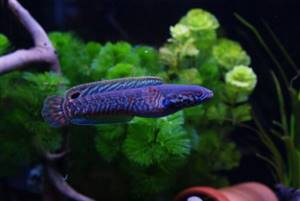
The young specimen looks very much like a snake. It has a small rounded tail and a fin stretched across the entire back. The color of a young snakehead is greenish-brown with red-orange stripes on the sides. As they grow older, these stripes turn black.
The individual is distinguished by a special respiratory system that allows it to breathe air. Along with gills, fish have breathing sacs. This is what forces the snakehead to surface from time to time for a new portion of air.
The marine representative is capable of reaching a length of up to 1.5 meters and a weight of more than 7 kg.
